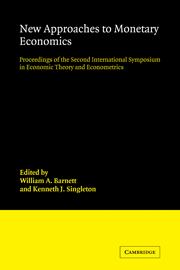 New Approaches to Monetary Economics
New Approaches to Monetary Economics Book contents
- Frontmatter
- Contents
- Editors' introduction
- List of contributors
- Part I Transactions motivated monetary holdings in general equilibrium
- Part II Financial intermediation
- Part III Monetary aggregation theory
- Part IV Issues on aggregate fluctuations
- Part V Theoretical issues in the foundations of monetary economics and macroeconomics
- 15 Pricing and the distribution of money holdings in a search economy, II
- 16 The optimal inflation rate in an overlapping-generations economy with land
- 17 Some unsolved problems for monetary theory
15 - Pricing and the distribution of money holdings in a search economy, II
Published online by Cambridge University Press: 04 August 2010
- Frontmatter
- Contents
- Editors' introduction
- List of contributors
- Part I Transactions motivated monetary holdings in general equilibrium
- Part II Financial intermediation
- Part III Monetary aggregation theory
- Part IV Issues on aggregate fluctuations
- Part V Theoretical issues in the foundations of monetary economics and macroeconomics
- 15 Pricing and the distribution of money holdings in a search economy, II
- 16 The optimal inflation rate in an overlapping-generations economy with land
- 17 Some unsolved problems for monetary theory
Summary
The circular flow of purchasing power is a staple of introductory economics. Yet it scarcely appears in recent theoretical work. Examples of explicit modeling of the circular flow are Lucas (1980) and our (1985b). In these models, stochastic expenditure patterns and limited investment and borrowing opportunities result in a distribution of holdings of fiat money. This analysis focuses on the determinants of prices as well as the distribution of money holdings. In the absence of analyses of richer menus of financial assets, it seems more appropriate to think of these models as reflecting the finance constraint of Kohn (1981) rather than the money constraint of Clower (1967).
In the model, we distinguish two groups of agents – workers and capitalists. There is a Walrasian labor market and a sequential search retail market where prices are set by capitalists. There is a circular flow of money with workers holding money while waiting for stochastic purchasing opportunities and capitalists simply transfering money between markets (mail float).
Our assumptions are strong; they enable us to solve the model explicitly in the steady state. The model economy has a unique steady-state uniform price equilibrium in which the greater the efficiency of the search process in the retail market, the higher the levels of nominal and real wages. Whether the nominal price increases or decreases with search speed depends on the other parameters.
- Type
- Chapter
- Information
- New Approaches to Monetary EconomicsProceedings of the Second International Symposium in Economic Theory and Econometrics, pp. 311 - 324Publisher: Cambridge University PressPrint publication year: 1987
- 1
- Cited by
